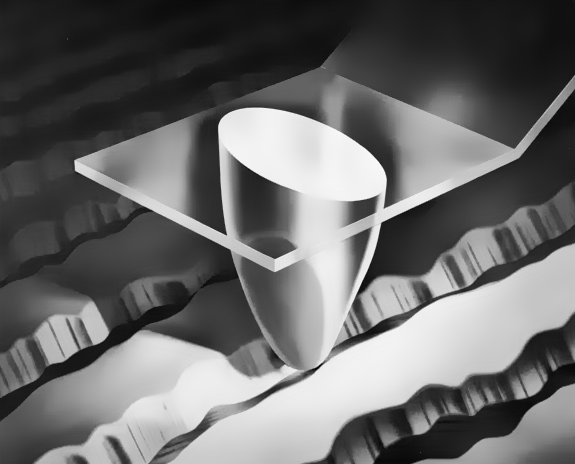


In the case of record care, we have the 1959 Library of Congress Report1 for reference. But no such reference work seems to exist for stylus care. A fairly thorough search of the Audio Engineering Society's E-Library failed to produce one serious paper on the cleaning of phonograph styli.
What follows is an attempt to formalise the problem, review the various options, and present some of our own experiences concerning stylus cleaning.
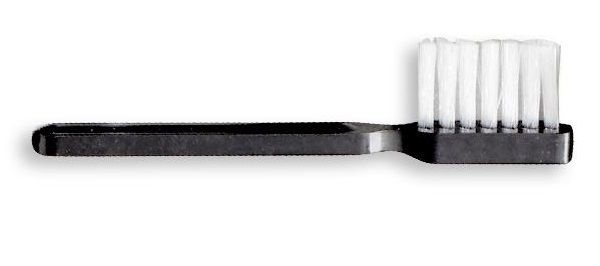 The first problem is one which will be familiar to anyone with experience of records. Not really a problem at the interface between the stylus and the groove walls at all, it is a problem which develops between the surface of the disc (the land) and the cantilever.
The first problem is one which will be familiar to anyone with experience of records. Not really a problem at the interface between the stylus and the groove walls at all, it is a problem which develops between the surface of the disc (the land) and the cantilever.
Shure pointed out many years ago2 that a thread of lint, wrapped around the base of the stylus shank acts like a broom, collecting particles of dust into a "dust ball". If not visually spotted by the listener, this ball grows until it is big enough that it lifts the stylus up and away from the groove walls. The phenomenon usually creates serious distortion and the ball of dust must be removed from the stylus for the record to play properly.
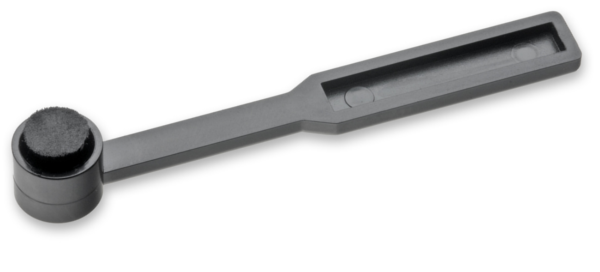 Clearly, this type of contamination is easily dealt with. The simplest small nylon brush (like that shown above right) is sufficient to dislodge the dust and fluff from the shank of the stylus. It may even be possible to remove the dust-ball without physically touching the stylus using a dust blower. (Never blow on the stylus with the mouth as this will deposit saliva.) Alternatively, a carbon-fibre brush (left) provides a gentler alternative.
Clearly, this type of contamination is easily dealt with. The simplest small nylon brush (like that shown above right) is sufficient to dislodge the dust and fluff from the shank of the stylus. It may even be possible to remove the dust-ball without physically touching the stylus using a dust blower. (Never blow on the stylus with the mouth as this will deposit saliva.) Alternatively, a carbon-fibre brush (left) provides a gentler alternative.
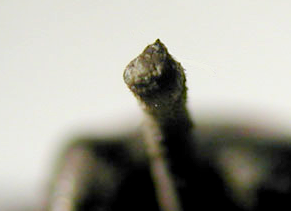 What of more stubborn residue which collects around the stylus and even the cantilever which a dry brush won't remove?
What of more stubborn residue which collects around the stylus and even the cantilever which a dry brush won't remove?
As we have seen, the mechanism which interferes with the correct pressure between the stylus and the groove walls is due to dust-ball build up around the stylus shank in the land-cantilever gap. Any process which reduces this gap size, or increases the diameter of the shank; for example, fouling of the cantilever and shank due to residue build up (right), will reduce the amount of dust and lint necessary before contact between the groove walls and the stylus is compromised. Thus, a clean stylus assembly will give good results for longer than will a dirty assembly. This, we call Problem 2.
In truth, the fundamental mechanism causing Problem 2 is no different from Problem 1. But, the resolution is different and more complicated.
The surface of a diamond is hydrophobic and demonstrates a strong affinity to stick to oil and grease. In fact, diamonds are sorted from the rock from which they are mined using grease (the diamonds stick to grease, but the rock doesn't). So, we can assume that any stylus will accumulate some grease and oil from cooking vapours and from industrial and traffic pollution after only a few hours play. It will collect these largely from the spiral groove itself. And it will pick up a nice dollop of body oil if the "needle" is scratched with the finger prior to play as too many vinylistas do!
It is probably this oil and grease, either air-borne or thrown up from the groove, which lie at the sticky heart of the residue of our Problem 2.
Is there a point where the residue adds sufficiently to the mass of the moving parts that the dynamical system is altered?
Clearly there is but, let us assume that this sticky gunk is something like soot. The density of a diamond is 3.51 g/cm3, and the density of aluminium (a common shank and cantilever material) is 2.70 g/cm3 whereas the density of soot (for example, from a diesel engine) is around 0.5 g/cm3 and the density of oil is around 0.9 g/cm3. Thus, the amount of residue necessary to change the dynamic system alignment would certainly be causing problems due to reduced dust-resistance before it added any significant mass.
What are our options in resolving Problem 2?
We are dealing here with grease and oil, so the obvious technique is to use a solvent and apply this to the stylus via something mildly abrasive. It seems as if a small brush and a dilute solution of distilled water and lower alcohols is really all we need.
There is, however, a fly in the ointment ...... If alcohol is employed to clean phonograph styli it may act to weaken the cement joint between the stylus and cantilever. And any alcohol which creeps up the cantilever may have a deleterious effect on the elastomer bearings. As far back as 1964, Cecil Watts, the inventor of a range of record and stylus cleaning products, gave this stern warning,
"It cannot be too strongly emphasised that if sufficient alcohol is used to cause any free fluid to be transferred to the stylus, damage to the pick-up may well result."4
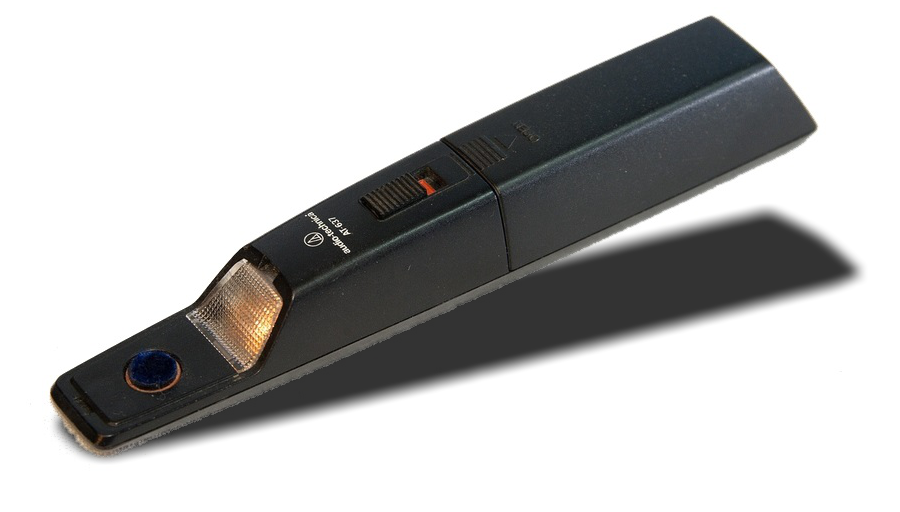 So, what might be done to remove the grease and oil and contaminants from the diamond stylus without employing a liquid solvent for the grease and oil? One option would appear to be one of the, so called, ultrasonic cleaners. These all derive from the original Audio Technica 637 (shown left). Unfortunately, these devices are misnamed and simply vibrate a brush at an audio frequency. They are thus are not "ultrasonic" at all ...... Well, unless you are a tuna fish5.
So, what might be done to remove the grease and oil and contaminants from the diamond stylus without employing a liquid solvent for the grease and oil? One option would appear to be one of the, so called, ultrasonic cleaners. These all derive from the original Audio Technica 637 (shown left). Unfortunately, these devices are misnamed and simply vibrate a brush at an audio frequency. They are thus are not "ultrasonic" at all ...... Well, unless you are a tuna fish5.
Real ultrasonic cleaning works by agitating the parts by cavitation, whereas these devices are simply a variation on a brush the way an electric toothbrush is a variation on a normal toothbrush. Dislodging the grease and oil still requires a solvent and we want to try to avoid this.
To be fair, Audio Technica, never claimed that the cleaner was "ultrasonic", only "electronic". The idea that these devices are ultrasonic just seems to have developed as an urban myth.
Another option is to use a mildly abrasive surface (sandpaper or glasspaper) to polish the diamond and remove any contaminants. This is an effective technique, but it requires a steady-hand, skill and nerve. It is easy to over-stress the cantilever bearings and styli with very fine scanning radii (Shibata, line-contact etc.) may be damaged in the process. It's also impossible to perform if the cartridge is installed in the arm. Fine if you have a detachable headshell but very time consuming if you don't. And what of the extremely abrasive material left by the polishing? It is manifestly undesirable that any of this finds itself back in the record groove.
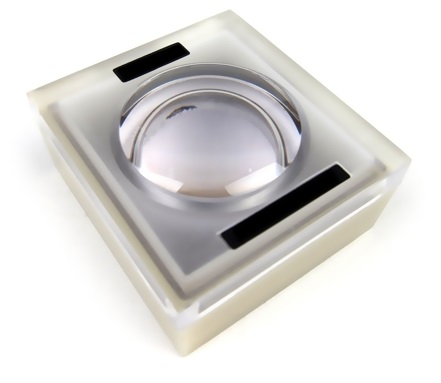 An attractive solution to cleaning the stylus without alcohol is to dip it into something which adheres to the contaminants, but not to the diamond. Various manufactures have provided products which are variations on this theme; mostly employing polymer gels. A gel is mostly liquid, trapped by surface-tension in a solid, cross-linked polymer structure. It is the cross linking that gives gel its tackiness, and it is the tackiness which makes it a potential cleaning solution.
An attractive solution to cleaning the stylus without alcohol is to dip it into something which adheres to the contaminants, but not to the diamond. Various manufactures have provided products which are variations on this theme; mostly employing polymer gels. A gel is mostly liquid, trapped by surface-tension in a solid, cross-linked polymer structure. It is the cross linking that gives gel its tackiness, and it is the tackiness which makes it a potential cleaning solution.
Stylus cleaning-gels appear to be (silicon) hydrogels similar to those made for medical applications and those sold as resonance control pads for drums and cymbals (RTom's Moongels). These are not dissimilar to the tacky gels designed to stick to windows as temporary decorations. Anyone who has dropped one of the latter will know how well house dust sticks to the tacky surface.
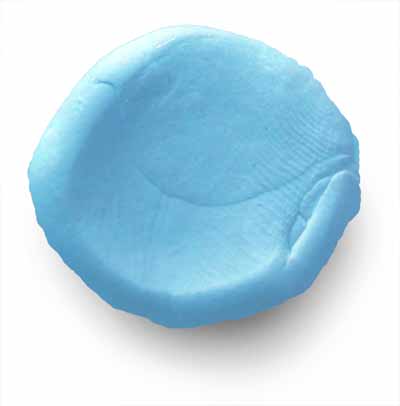 DIY "dunking" methods tend to be based on various types of polymer putty. The use of a British product made by Bostik known as Blu Tack is widely reported, as is the Crayola LLC product known as Silly Putty. Both are curious, sticky materials which date from failed attempts to make artificial rubber during the Second World War.
DIY "dunking" methods tend to be based on various types of polymer putty. The use of a British product made by Bostik known as Blu Tack is widely reported, as is the Crayola LLC product known as Silly Putty. Both are curious, sticky materials which date from failed attempts to make artificial rubber during the Second World War.
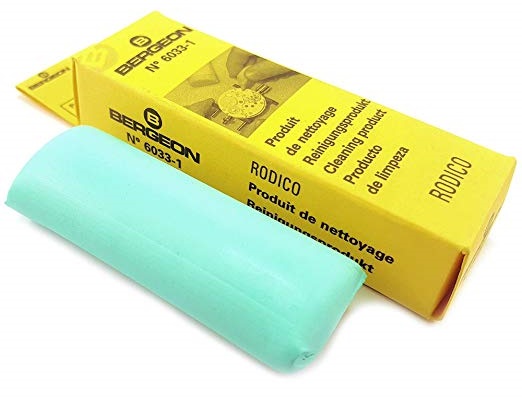 Blu Tack's composition is a manufacturing secret but it is known that its basic material is a very sticky polymer mitigated with minerals and mineral oils. It is the mineral oil which leaves the residue on the fingers after handling Blu Tack and it is known that the fillers are metallic in origin. Silly Putty too, although mostly dimethylsiloxane - a polymer created by reacting boric acid with silicone oil - has additives when marketed as a toy; among them are crystalline quartz (sand) and castor oil, Some vinyl enthusiasts claim a better putty is Rodico, manufactured by Bergeon in Switzerland.
Blu Tack's composition is a manufacturing secret but it is known that its basic material is a very sticky polymer mitigated with minerals and mineral oils. It is the mineral oil which leaves the residue on the fingers after handling Blu Tack and it is known that the fillers are metallic in origin. Silly Putty too, although mostly dimethylsiloxane - a polymer created by reacting boric acid with silicone oil - has additives when marketed as a toy; among them are crystalline quartz (sand) and castor oil, Some vinyl enthusiasts claim a better putty is Rodico, manufactured by Bergeon in Switzerland.
It is rare to find a watchmaker who does not have a stick of Rodico (6033) or horologer's putty in the tool cabinet. Like Blu Tack and Silly Putty, Rodico has a slightly sticky feel (but less so than either of the others). Another secret formulation, it is thought to be a variation of the gum arabic erasers that artists use. Unlike the Bostik and the Crayola products, Rodico is intended as a cleaning putty.
Horologers - including those working for the great brands such as Patek Philipe - have used Bergeon's Rodico for decades. Despite its distinguished connections, it is inexpensive and easy to obtain.
BASF's Basotect is used as an acoustical treatment for concert halls and recording studios. It is a melamine-formaldehyde resin foam (a melamine foam) and offers the properties of high acoustic absorption, low weight and fire-resistance necessary in such applications.
Looked at with an electron microscope (right), Basotect has an open-cell foam structure. The fine strands are as hard as glass, but the "empty space" ensures the product remains flexible.
Around the turn of the century, scientists at Procter and Gamble discovered that Basotect is gently abrasive and may be exploited as a cleaner with exceptional properties. They developed a product called Magic Eraser based on white Basotect-W which is widely copied by other manufacturers today.
Many vinylistas on-line have experimented with Magic Eraser as a stylus cleaner. The stylus is "dunked" into the foam so that the micro-fibres act as a "3D sandpaper" cleaning the stylus on all sides.
By the time a "needle" looks like the one illustrated above, you probably ought to be thinking about changing it; rather than cleaning it!
For a long time, stylus cleaning started and ended for us with a simple, nylon brush before and after playing. Nothing more than regular cleaning of "the needle" with a small brush seemed required beyond recording the number of hours a cartridge has been used to avoid subjecting records to a stylus with excessive wear.
Residue build-up never seems to have been a great issue for us. Perhaps because we clean the stylus with a brush before and after playing; we make sure we only play clean records; and - above all - we make sure we never play a record wet, or even damp6.
We also inspect and change styli regularly (at 500 hours) and thereby possibly sidestep the problem. By the time a "needle" looks like the gunked one illustrated above, you probably ought to be thinking about changing it; rather than cleaning it!
Our experience with adhesive cleaning is that the techniques remove dust build-up, but little else. In this, they reveal no great advantage over a simple brush except to obviate the requirement for the dexterity in gentle brushing. Granted, this may be a significant advantage if the turntable is mounted somewhere inconvenient or, for some other reason, sight of the stylus is impaired. We have steered-clear of Blu Tack and Silly Putty for fear that swapping house-dust for a contamination of sand and castor oil is no good exchange!
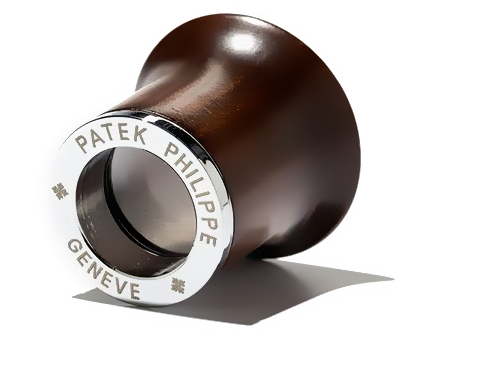
What we do notice (well before significant gunking) is a "darkening" of the jewel after only a few hours play when visually inspected using a high-quality watchmakers' eyeglass (20 ×) or with a hand-held microscope (60 ×); This is evident in a wide range of different cartridges and stylus types.
We have not found that polymer gels or Rodico do anything to remove this thin layer of material. We conjecture the "darkening" must be due to a layer of oil and grease because cleaning with an alcohol moistened cotton-bud restores the translucence to the diamond. Given that we want to avoid alcohol-based cleaning, how to achieve this by other means has remained a conundrum for a long time.
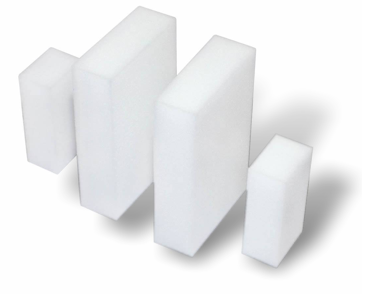
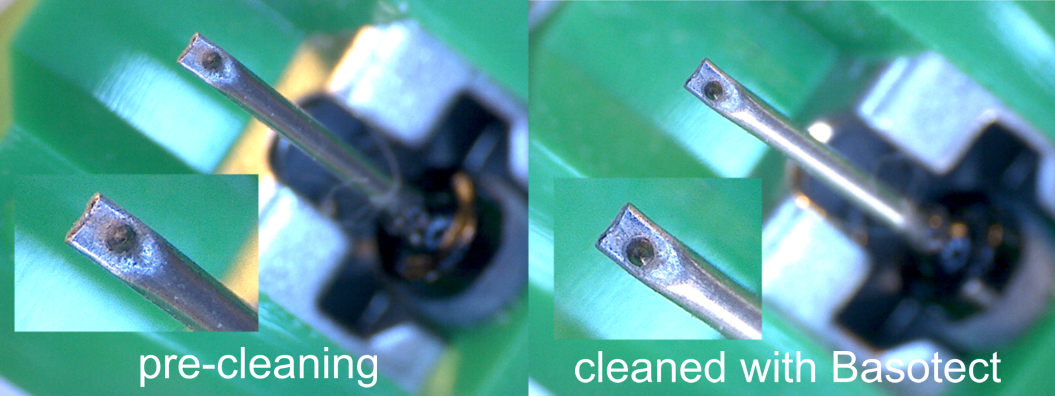 Some recent experiments allow us to report very good results in removing these contaminants using BASF's Basotect (Magic Eraser). If the stylus is dipped a half-a-dozen or so times into the soft foam a little more vigorously than you would normally cue a record, the stylus is returned to its original condition quickly, gently and without liquid solvents. For once, the adjective chosen by Procter and Gamble's marketing team seems appropriate.
Some recent experiments allow us to report very good results in removing these contaminants using BASF's Basotect (Magic Eraser). If the stylus is dipped a half-a-dozen or so times into the soft foam a little more vigorously than you would normally cue a record, the stylus is returned to its original condition quickly, gently and without liquid solvents. For once, the adjective chosen by Procter and Gamble's marketing team seems appropriate.
It really is extraordinary to witness the excellent results secured from such a gentle interaction between the cleaning medium and the stylus.
1. Preservation and Storage of Sound Recordings. Pickett, A.G.; Lemcoe, M.M. (US) Library of Congress Report 1959
2. Phonograph Reproduction - 1978. Anderson, R. et al. AUDIO May 1978
3. ROLE OF SCANNING ELECTRON BEAM MICROSCOPE IN DISC RECORDING, Alexandrovieh G., presented at the 58th Convention of JAES November4-7, 1977
4. A guide to the better care of LP and Stereo Records. Watts, C.E. Cecil E.Watts Ltd. 1964
5.
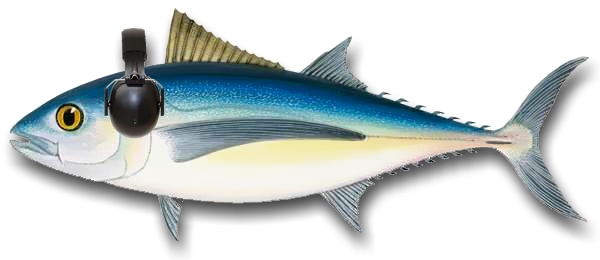
The poor tuna fish seems to be cursed with one of the poorest hearing systems in the animal kingdom, with a range four-octaves from about 50Hz to 1kHz. The animal with the widest range (16Hz to 44kHz) is that well known audiophile, the ferret.
6. Wet playing does result in unwanted residue. We keep styli separate if they have ever been used on damp CD-4 discs. This is a very special case.
 Pspatial Audio Home page
Pspatial Audio Home page
For all support issues, go here.
For Pspatial Audio sales, email: sales@pspatialaudio.com
